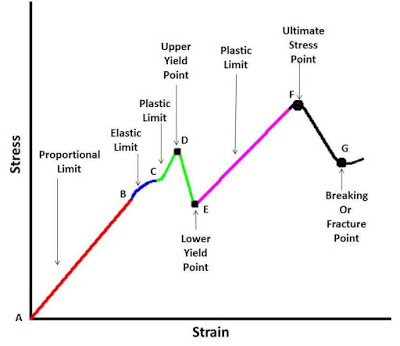Today we are going to learn about elastic constant or more appropriate young modulus of elasticity. In our previous articles we have learnt about strain, stress and their types and relationship. In stress strain curve article, we have learnt about proportional limit and I have discussed about a constant there. This constant is known as young modulus of elasticity.
Don’t worry if you have missed that article. In this article we will to learn it from basic and also describe its value for some basic materials.
Let’s start the article.
Young modulus of elasticity:
Before learn about young modulus you should know about strain and strain. I am giving a brief introduction about them. If you want to learn them completely, kindly follow the link given below their definitions.
Stress:
Resistant Force applied per unit area of any cross section is known as stress. For ideal conditions, the applied force is equal to the resisting force so the ratio of the applied force to cross section area of any object is known as stress. It is the resistant force which resists the deformation in any body. For more detail click Stress and its Types.
Strain:
The ratio of change in dimension to original dimension is known as stain. This dimension is taken only in one direction. In common words the change in length to original length under loading condition is known as strain. For more detail click Strain and its Types
Young Modulus of Elasticity:
For understanding this elastic constant, first read the diagram given below.
It is stress strain curve for a ductile material. This diagram is obtain by applying an increasing load on a specified dimension specimen and observe its behavior and change in dimension. The region AB is known as proportional limit and AC is known as elastic limit. Under the elastic limit the stress is directly proportional to the strain. This law is known as Hooke’s law. The proportionality constant of Hook’s law is known as young modulus of elasticity.
According to the definition,
The ratio of direct stress to longitudinal stain under elastic limit is known as young modulus of elasticity. Its unit is same as that of stress which is newton per meter square (N/m2). This constant is independent on any constrain like dimension of object, applied load etc. and unique for every material. It is only depended upon material type and varied for material to material.
For practical observation let us now consider an object of length L having area of cross-section equal to A. If the force F acting on the wire, and the change in length due to loading is ∆L
Practical observation by Young modulus:
We have discussed that every unique material have unique value of young modulus. If a material has high value of this constant, it means that this material specimen or object required high value of force to little change in its original dimension. It is less elastic or that material got a little variation in its dimension for a high value of stress. It can say that the high value of modulus shows high rigidity of the material. The value of this modulus for steal is 210 GN/m2.
If a material has low value of this constant means the material is high elastic or it shows a very high deformation for small value of loading. The value of young modulus of aluminum is 70 GN/m2.
Table of Modulus of Elasticity for some common material:
|
S.No.
|
NAME OF MATERIAL
|
VALUE OF YOUNG MODULUS
( GN/m2 )
|
|
1.
|
Plastics
|
1 – 3
|
|
2.
|
Aluminum
|
70
|
|
3.
|
Brass
|
100 – 125
|
|
4.
|
Carbon Fiber
|
150
|
|
5.
|
Copper
|
120
|
|
6.
|
Glass
|
50 – 90
|
|
7.
|
Diamond
|
1200
|
|
8.
|
Gold
|
75
|
|
9.
|
120 – 130
|
|
|
10.
|
Iron
|
210
|
|
11.
|
Stainless Steel
|
180 – 190
|
|
12.
|
Tungsten Carbide
|
450 – 650
|
|
13.
|
Nylon
|
0 – 5
|
This is complete information about young modulus of elasticity at beginner level. If you have any query regarding this article, ask by commenting. If you like this article, don’t forget to share it on social network with your friends. Subscribe our website for more informative articles. Thanks for reading it.



